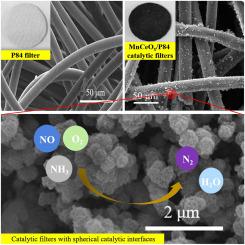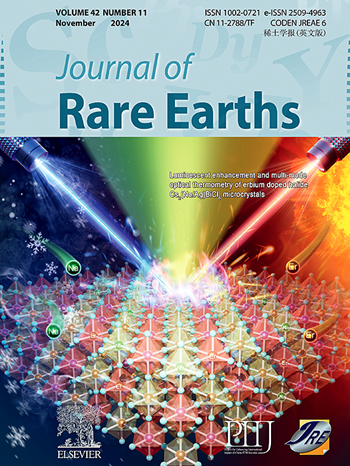Structure–performance relationship between denitration performance and catalytic interface morphologies of MnCeOx/P84 catalytic filters
IF 7.2
1区 化学
Q1 CHEMISTRY, APPLIED
引用次数: 0
Abstract
MnCeOx/P84 catalytic filters with spherical, flower-like, cubic and rod-like catalytic interfaces were synthesized respectively, and their catalytic activities in the NH3-SCR reaction were investigated. The MnCeOx/P84 catalytic filter with spherical catalytic interfaces (recorded as S-MnCeOx/P84) exhibits the best catalytic denitration performance. The NOx removal efficiency of S-MnCeOx/P84 reaches the highest value of 98.6% at 160 °C when the catalyst loading is 100 g/m2. At the same time, S-MnCeOx/P84 exhibits good SO2 resistance and stability, achieving a NOx removal rate of 83% at 190 °C with 30 ppm SO2. The characterization results illustrate that the MnCeOx active component in S-MnCeOx/P84 is present in weak crystalline states, tightly wrapped around the surface of the filter fiber, and uniformly dispersed, and the mesopore is the main pore structure of the S-MnCeOx/P84, which can provide a channel for the catalytic reaction to proceed. At the same time, transmission electron microscopy (TEM) characterization shows that γ-MnO2 is the main form of MnO2 in the S-MnCeOx/P84. Further analysis of H2 temperature programmed reduction (H2-TPR), NH3 temperature programmed desorption (NH3-TPD) and in-situ diffuse reflectance infrared spectra (DRIFTS) show that S-MnCeOx/P84 has good redox ability at 100–200 °C and has abundant Lewis acid sites and Brønsteds acid sites, which provides an important guarantee for its superior low-temperature NH3-SCR denitration performance.

MnCeOx/P84催化过滤器脱硝性能与催化界面形貌的结构性能关系
分别合成了球形、花状、立方状和棒状催化界面的MnCeOx/P84催化过滤器,并考察了它们在NH3-SCR反应中的催化活性。具有球形催化界面的MnCeOx/P84催化过滤器(记为S-MnCeOx/P84)表现出最佳的催化脱硝性能。当催化剂负载为100 g/m2时,S-MnCeOx/P84的NOx去除率在160℃时达到最高值98.6%。同时,S-MnCeOx/P84具有良好的抗SO2性能和稳定性,在190℃、30 ppm SO2条件下,NOx去除率达到83%。表征结果表明,S-MnCeOx/P84中MnCeOx活性组分以弱结晶状态存在,紧密包裹在过滤纤维表面,分散均匀,中孔是S-MnCeOx/P84的主要孔结构,为催化反应的进行提供了通道。同时透射电镜(TEM)表征表明,γ-MnO2是S-MnCeOx/P84中MnO2的主要形式。进一步分析H2程序温度还原(H2- tpr)、NH3程序温度脱附(NH3- tpd)和原位漫反射红外光谱(DRIFTS)表明,S-MnCeOx/P84在100-200℃具有良好的氧化还原能力,具有丰富的Lewis酸位点和Brønsteds酸位点,这为其优异的低温NH3- scr脱硝性能提供了重要保证。
本文章由计算机程序翻译,如有差异,请以英文原文为准。
求助全文
约1分钟内获得全文
求助全文
来源期刊

Journal of Rare Earths
化学-应用化学
CiteScore
8.70
自引率
14.30%
发文量
374
审稿时长
1.7 months
期刊介绍:
The Journal of Rare Earths reports studies on the 17 rare earth elements. It is a unique English-language learned journal that publishes works on various aspects of basic theory and applied science in the field of rare earths (RE). The journal accepts original high-quality original research papers and review articles with inventive content, and complete experimental data. It represents high academic standards and new progress in the RE field. Due to the advantage of abundant RE resources of China, the research on RE develops very actively, and papers on the latest progress in this field emerge every year. It is not only an important resource in which technicians publish and obtain their latest research results on RE, but also an important way of reflecting the updated progress in RE research field.
The Journal of Rare Earths covers all research and application of RE rare earths including spectroscopy, luminescence and phosphors, rare earth catalysis, magnetism and magnetic materials, advanced rare earth materials, RE chemistry & hydrometallurgy, RE metallography & pyrometallurgy, RE new materials, RE solid state physics & solid state chemistry, rare earth applications, RE analysis & test, RE geology & ore dressing, etc.
 求助内容:
求助内容: 应助结果提醒方式:
应助结果提醒方式:


